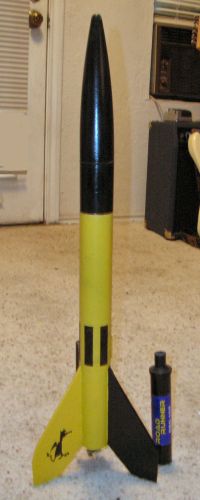Scratch Maxi Scamp Original Design / Scratch Built
Scratch - Maxi Scamp {Scratch}
Contributed by J Stuart Powley
| Manufacturer: | Scratch |

Brief:
I've always been a fan of the mid-'70s Estes fleet. I cloned a Goblin a couple of years ago and I was looking to do
something that would compliment it well. Upon looking through my '77 Estes catalog I settled on the Scamp. However, the
spare parts I had weren't quite right. What could I do with a BT-60 body tube and plastic nose cone? How about a Scamp
upscale?! Thus, the Maxi-Scamp was born.
Construction:
The rocket uses a 15 inch long BT-60 body, a standard BT-60 plastic Estes nose cone, 3/16 inch plywood fins, a 29mm
motor mount, two regular Estes launch lugs (one inch long each), one 5/16 x 5.5 inch launch lug (the one you really
use), three feet of 1/4 inch sewing elastic, and an old nylon flare chute, and a positive motor retention device of my
own design.
The rocket went together well. After all, it is pretty much a standard 3FNC model. The fins were the biggest part of the project (other than the finishing) and were shaped using my trusty Dremel tool. They were attached by making a series of holes along the body tube where the root edge meets it and allowing the epoxy to seep into the holes as each fin is attached. It's not quite as strong as through the wall fins but it's still pretty strong. The motor mount was glued in using far more epoxy than was probably needed, but I wasn't taking any chances. The shock cord was mounted using the old Estes method but with a whole lot of epoxy there too. I wanted the rocket to have a "low power" look so I put on standard Estes launch lugs like were on the original. However, I then put on the heavy duty lug on the other side so it could actually take off without whipping the rod like crazy. I wanted to be real sure the motor stayed in place, so I took two small plastic tubes and epoxied them on each side of the motor mount then threaded in two screws and rigged two wires to run across the bottom of the motor. Changing the motor takes a little time, but it's not going anywhere.
I also added 2oz of nose weight to ensure I would not have any stability issues.
Finishing:
The model was painted using black and yellow H2O paint by Krylon, which doesn't make me break out in hives. It was
fairly easy to mask off the one black fin and top black part. On the original, only the nose cone is painted black.
Since my parts are not exactly scale, I had to extend the black part down the body 2.5 inches to get it to look right.
I then scaled up the decals that I downloaded from Jimz, put them on, hit them with sealer, and that was it! Now I only
had to get up the nerve to fly it.
Flight:
I decided to fly the Maxi-Scamp for the first time at NSL 2006. I was thinking about using a small motor and then
working my way up to the bigger ones, but I got a great deal on a Roadrunner G80-10. If you've never flown a
Roadrunner, you should. They're maxed out and quite frankly scream. I screwed in my motor and put the Scamp on the pad.
The simulation program that I had used said it should go over 3000 feet. I was pretty sure I wasn't going to see it
again.
When the button was pushed there was a mighty woosh from the G and a plume of black smoke that just kept going up and up and up... Soon I lost sight of it completely. I felt a little stupid for putting that much motor in it for its first flight, but everyone had gotten quite a show. I just hoped I had caught it with my camera. As it turns out, about an hour later a guy came walking up to me holding the Scamp! She was driving back to the field after lunch and it drifted down right in front of her car, about a mile from the range head. It was especially cool because all I caught with my camera was a bunch of smoke.
The second flight was at a Hotroc event. This time I was a little saner and flew it on a Roadrunner F. Since there was no wind, it landed about 50 yards from the pad straight up on its fins! I haven't flown it since. I figure I've just about used up my luck.
Summary:
I really like this model and may retire it now. The main pro is that it has the lines and "flavor" of the
Estes original while having incredible mid-power performance. It goes well with my Goblin and I've ordered a PD A-20
Demon to complete the trio. The main con is that that incredible performance makes every launch a risk of being the
last time you'll ever see it. All in all, a winner I'd say!
 |
 |